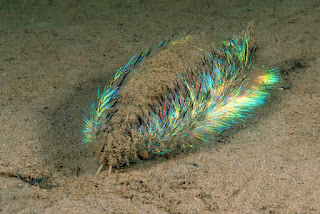Chaetopterus

CHAETOPTERUS CLASSIFICATION : Phylum : Annelida Class : Polychaeta Genus : Chaetopterus COMMENTS : •Commonly a Paddle worm. •It is usually 15 cm to 35 cm in length. •The body is divisible into three distinct regions - anterior , posterior & middle . •The anterior region is flat, and usually has nine pairs of simple parapodia which are expanded notopodia, samall prostonium and a funnel shaped peristomial collar with a pair of peristomial cirri & mouth . •Middle region comprises five segments , first anterior most is produced laterally into great wings directed forwards, next segment carries a pair of suckers & the rest there are segments carry membranous folds so called fans formed by the fusion of the notopodia . •Posterior region comprises thirty similar segments which are devoid of setae •Mouth is wide & funnel-shaped . •The food comprises mainly small organisms which are carried by the currents of water set up by fans. It is a the filter feeder . ...







